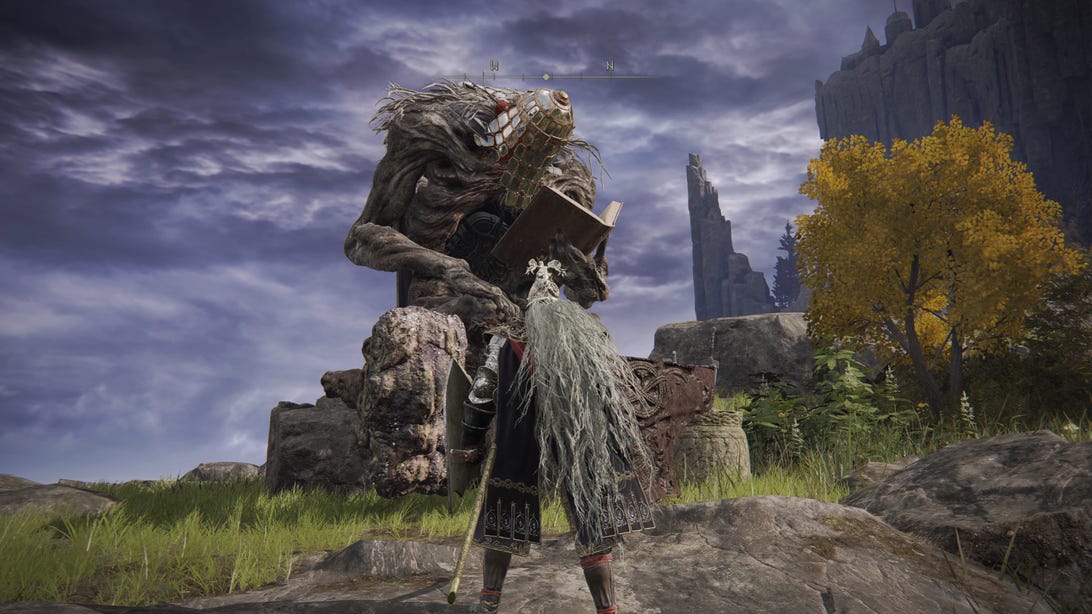
Death is only an ill-calculated leap away.
From Software
Almost everything in Elden Ring will try to kill you — mercilessly, repeatedly, in creative and often unavoidable ways. More often than not, they will succeed. And once you get past the inevitable anger and frustration, you’ll probably love it. FromSoftware games even have a reputation for using death as a mechanism to guide players to better decisions, level-appropriate interactions, and the unbridled satisfaction of defeating an enemy that has impaled you dozens of times.
But looking beyond the mechanics of what will become one of the most talked-about games of 2022 poses a question: What does Elden Ring teach us about death positivity?
Popularized by author and undertaker Caitlin Doughty, death positivity is a social movement that encourages people to speak openly about death and dying. It by no means says that death is a positive thing, but rather it is a push to destigmatize the conversation around death so that we can better understand and prepare for it.
Entertain your brain with the coolest news, from streaming to superheroes, memes to video games.
Depending on the direction you take in Elden Ring, you could be consumed by a dragon, crushed by contract giants, speared by birds with swords for legs, pierced by weapons larger than your entire body and, more often than not, killed by jumps that are a little too high for your internal organs to handle. The height of that jump? Largely inconsistent, so good luck figuring it out.
With all that on the table, Elden Ring and his ilk force us to face death productively, even if we don’t openly realize it’s steering us in that direction. But when we think of “death games” as a genre, it’s not really the model of what you’d normally expect.
What Remains of Edith Finch is a visually stunning game that discusses grief, family and tragedy.
Annapurna Interactive
Games designed to be about death often serve a very transparent purpose. Think A Mortician’s Tale, Spiritfarer and What Remains of Edith Finch. Whether it’s helping us work through grief, work through our eventual demise, or even spark a discussion about a concept considered taboo in many cultures, these games are designed to tackle death in a way. which gives meaning or solution to the player.
Death is central to the story of those games: you know exactly what you’re getting into when you start one. While Elden Ring is a game that is overwhelmingly about death, most people who play it might not be interested in thinking critically about what that really means.
For the average player, as with its Dark Souls predecessors, Elden Ring is nothing more than a very difficult fantasy game that has you wandering around and getting completely defeated by enemies in the name of fun. Players are there to kill bosses and conquer lands. And that’s definitely the game. Thousand percent. Nobody says it isn’t. But it is also so much more.
Hidetaka Miyazaki, creator of Elden Ring and Dark Souls, openly refers to death as a core feature of the game, rather than a hindrance. In this incredible piece by Simon Parkin for The New Yorker, Miyazaki explains, “Death and rebirth, trying and conquering – we want that cycle to be enjoyable. In life, death is a terrible thing. In game, it can be something else.” .”
The reason for the game’s story (as described in the introduction, so no major spoilers) is that thanks to the theft of a special Death rune, nobody in the world of Elden Ring can actually die. Players and NPCs alike are doomed to fight over and over – appearing again and again – and your job is to restore order to the world by restoring true death.
Elden Ring cliff notes for the intro:
The Ring is not the One Ring, it is not something you wear. The ring itself consists of laws in runes that dictate the natural order of life, a golden rule.
Someone stole the rune of death, so now no one can die. Your goal is to fix this.
— Gene Park Souls (@GenePark) February 28, 2022
Conflict in Elden Ring arises as everyone is trapped in a destructive cycle of eternal life – without the ability to face death, the world becomes a wilderness of conflict and chaos. This world needs death to function and thrive.
And so the game teaches players that while real death is an inevitable, unavoidable obstacle, it is also a very important and necessary part of life. Some of the key principles of death positivity—discussion, destigmatization, and transparency—are crucial to keep moving forward.
In Elden Ring, one of the best ways to transcend death is to talk about it with other players and the community. Forming strategies, teaming up with fellow adventurers, and whining about repeated deaths with your friends all serve to unite players in a common goal and contribute to your ultimate ability to face death.
What we don’t actively realize, however, is that through play and open community discussions, we subconsciously teach ourselves to face the reality of death in a positive way. Yes, in video games the stakes are low. But in Elden Ring of Dark Souls, the stakes feel higher, because when you’re up against a particularly tough boss, it’s nearly impossible not to get caught up in the suspense. It’s brutal. We share that experience together and bear the brunt as a community, even if we face the challenges alone.
Then, when it comes time to face the hardships and pain of a real-life death — be it a loved one, or even your own final moments — we naturally remember that transparency, community, and shared experience are intense create opportunities for growth and understanding through the pain.
Imagine being attacked by this man.
Bandai Namco/Screenshot by Daniel Van Boom
As someone with a professional interest in the intersection of death, technology, and culture, my playthrough of Elden Ring was a reminder that positivity about death can be found in the most unlikely of places.
I’m not done yet, so I’m not sure how well the endgame story aligns, but if other FromSoftware games have anything to offer, I’m pretty confident that even the story itself will serve as a conduit for death positivity. In fact, almost all FromSoftware games are about death and rebirth — even Bloodborne, where (spoiler alert) players hunt for parts of an umbilical cord.
I find that I still get frustrated every time I get killed. Every “YOU DIED” message in the middle of a boss fight puts me in a furious spiral. But the frustration and anger we feel when our characters die reflect the human experience of death.
It will be annoying and frustrating. It will hurt. It will be brutal and it will end up being one of the hardest things we have to face. In these early days, we have no choice but to work together, talk about it, come to terms and eventually move on.
Often in these painful, real-life moments, we turn to video games and media for comfort. And even in Elden Ring, a game that doesn’t seem particularly reassuring from the outside, you can find that.
Because by creating a game where players are actively encouraged to remain resolute in the face of guaranteed death, FromSoftware has created a game that has a fundamental understanding of death positivity. And for that reason alone, I will persist through every last in-game death – even if it kills me.
This post How Elden Ring teaches us to be more open about death
was original published at “https://www.cnet.com/tech/gaming/how-elden-ring-teaches-us-to-be-more-open-about-death/#ftag=CAD590a51e”



